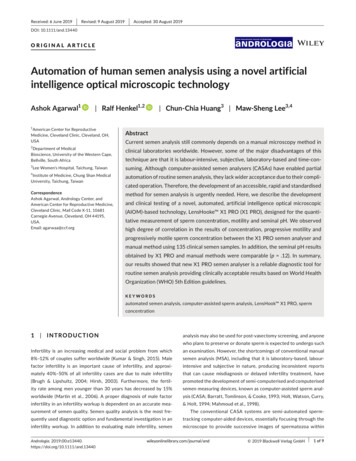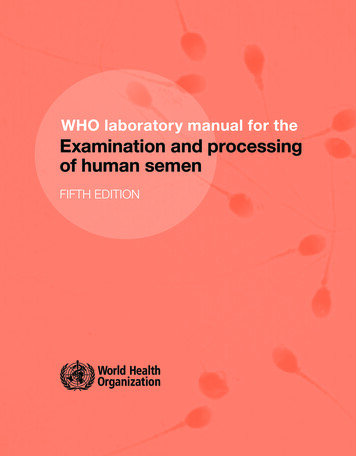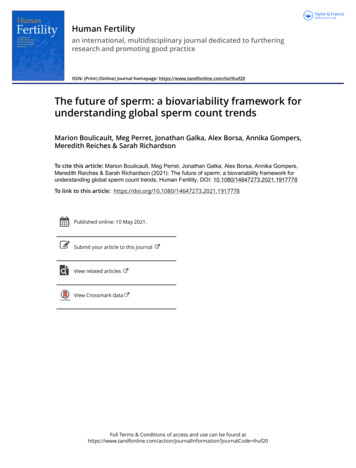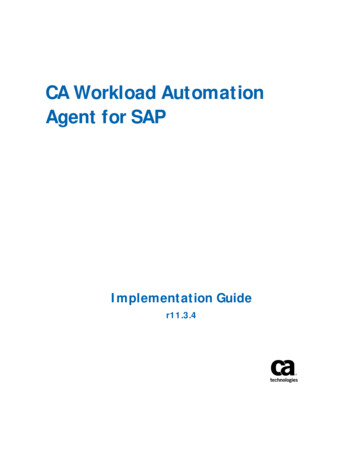
Transcription
DOI: 10.1111/and.13440ORIGINAL ARTICLEAutomation of human semen analysis using a novel artificialintelligence optical microscopic technologyAshok Agarwal1 1American Center for ReproductiveMedicine, Cleveland Clinic, Cleveland, OH,USA2Department of MedicalBioscience, University of the Western Cape,Bellville, South Africa31,2 33,4 AbstractCurrent semen analysis still commonly depends on a manual microscopy method inclinical laboratories worldwide. However, some of the major disadvantages of thistechnique are that it is labour‐intensive, subjective, laboratory‐based and time‐con‐Lee Women's Hospital, Taichung, Taiwansuming. Although computer‐assisted semen analysers (CASAs) have enabled partialInstitute of Medicine, Chung Shan MedicalUniversity, Taichung, Taiwanautomation of routine semen analysis, they lack wider acceptance due to their compli‐4Ashok Agarwal, Andrology Center, andAmerican Center for Reproductive Medicine,Cleveland Clinic, Mail Code X‐11, 10681Carnegie Avenue, Cleveland, OH 44195,USA.Email: agarwaa@ccf.orgcated operation. Therefore, the development of an accessible, rapid and standardisedmethod for semen analysis is urgently needed. Here, we describe the developmentand clinical testing of a novel, automated, artificial intelligence optical microscopic(AIOM)‐based technology, LensHooke X1 PRO (X1 PRO), designed for the quanti‐tative measurement of sperm concentration, motility and seminal pH. We observedhigh degree of correlation in the results of concentration, progressive motility andprogressively motile sperm concentration between the X1 PRO semen analyser andmanual method using 135 clinical semen samples. In addition, the seminal pH resultsobtained by X1 PRO and manual methods were comparable (p .12). In summary,our results showed that new X1 PRO semen analyser is a reliable diagnostic tool forroutine semen analysis providing clinically acceptable results based on World HealthOrganization (WHO) 5th Edition guidelines.automated semen analysis, computer‐assisted sperm analysis, LensHook X1 PRO, spermconcentration analysis may also be used for post‐vasectomy screening, and anyonewho plans to preserve or donate sperm is expected to undergo suchInfertility is an increasing medical and social problem from whichan examination. However, the shortcomings of conventional manual8%–12% of couples suffer worldwide (Kumar & Singh, 2015). Malesemen analysis (MSA), including that it is laboratory‐based, labour‐factor infertility is an important cause of infertility, and approxi‐intensive and subjective in nature, producing inconsistent reportsmately 40%–50% of all infertility cases are due to male infertilitythat can cause misdiagnosis or delayed infertility treatment, have(Brugh & Lipshultz, 2004; Hirsh, 2003). Furthermore, the fertil‐promoted the development of semi‐computerised and computerisedity rate among men younger than 30 years has decreased by 15%semen measuring devices, known as computer‐assisted sperm anal‐worldwide (Martin et al., 2006). A proper diagnosis of male factorysis (CASA; Barratt, Tomlinson, & Cooke, 1993; Holt, Watson, Curry,infertility in an infertility workup is dependent on an accurate mea‐& Holt, 1994; Mahmoud et al., 1998).surement of semen quality. Semen quality analysis is the most fre‐The conventional CASA systems are semi‐automated sperm‐quently used diagnostic option and fundamental investigation in antracking computer‐aided devices, essentially focusing through theinfertility workup. In addition to evaluating male infertility, semenmicroscope to provide successive images of spermatozoa withinAndrologia. 2019;00:e13440.https://doi.org/10.1111/and.13440 2019 Blackwell Verlag GmbH1 of 9
AGARWAL ET AL.a static field of view. These systems use special software to ex‐with normal and poor sperm quality were included, and samples withtract desired information and produce the desired output. If ap‐severe agglutination were excluded from the study.propriate protocols are followed, high precision and provision ofquantitative data on sperm kinetics are two major advantages ofCASA over MSA. In addition, CASA systems reduce the burden of measuring sperm tracks when individual tracking data are needed.Manual semen analysis was performed by at least two professionalAnother advantage is that any test samples can be analysed in atechnicians or licensed medical technologists of the hospital. Spermshort time.concentration ( 106/ml) was assessed by counting a minimum ofMost CASA systems allow partial automation in routine sperm200 spermatozoa in duplicate using a Makler counting chamberanalysis, but they have also shown limited success due to poor ac‐after liquefaction of the semen sample in a water bath at 37 C forcuracy at low and high sperm counts and the high cost of virtually30 min. Sperm motility (%) was evaluated at room temperature byall CASA devices. Moreover, different CASA systems use differentcounting at least 200 spermatozoa in duplicate using a phase‐con‐mathematical algorithms to calculate various sperm quality parame‐trast microscope at 400 magnification. At least five fields of viewters, leading to the greatest disadvantage in the clinical applicationfor each sample were examined, and spermatozoa were classifiedof CASA, with unreliability of comparative parameters across all de‐as progressively motile, locally motile and nonmotile as suggestedvices (Akashi, Mizuno, Okumura, & Fuse, 2005; Amann & Waberski,by the WHO 5th Edition (WHO, 2010). The seminal pH was manu‐2014; Dearing, Kilburn, & Lindsay, 2014; Kanakasabapathy et al.,ally measured 60 min after ejaculation with the pH paper (Merck2017; Lammers, Splingart, Barriere, Jean, & Freour, 2014). AlthoughColorfast pH strip, 6.5–10.0). Since pH measurements could not beCASA provides quantitative data on sperm kinetics, most CASA sys‐conducted at the Lee Women's Hospital, the data of only 58 patientstems still rely greatly on highly trained technicians and require anwere recorded for pH measurement from the rest of the institutions.additional bulky component for data collection and computationalunits for data analysis. The factors influencing the accuracy of theresults and the lack of quality control may lead to large variationsbetween different CASA systems and laboratories. Automated semen analysis was performed using the LensHooke To overcome these limitations, we integrated autofocus opticalX1 PRO semen quality analyser (Bonraybio Co., Ltd) for spermtechnology, artificial intelligence (AI) algorithms, electronic engi‐concentration, motility and seminal pH in compliance with theneering and a mechanical system all in one compact device. Hence,World Health Organization (WHO) 5th Edition (WHO, 2010). Thethe present study aimed to evaluate the clinical performance of theLensHooke X1 PRO technology is based on a built‐in high‐res‐novel artificial intelligence optical microscopic (AIOM)‐based tech‐olution and autofocus optical lens in combination with an artifi‐nology, LensHooke X1 PRO, in semen analysis by comparing itscial intelligence autocalculation system (Figure 1a). The rationaleresults with those of the manual microscopy method.for using the autofocus optical lens to replace the laboratory'smicroscope is based on the concept of the use of an automaticoptic inspection (AOI) system. In the context of the application of the AI algorithm, we use a predefined database to standardise the analysis and avoid subjective identification. The X1 PRO canfurther analyse sperm morphology based on the captured images.This study was approved by the Institutional Review Boards of ChungThe LensHooke X1 PRO detects the shapes of the target spermShan Medical University Hospital, Lin Shin Hospital, Lee Women'sand partitions the images of the sperm into head, neck and tailHospital in Taichung, Taiwan, and Min‐Sheng General Hospital inportions by methods such as the active contour model, and theTaoyuan, Taiwan. Written informed consent was acquired from alllengths and widths of each portion of sperm are calculated ac‐subjects.cordingly. An image classifier can be intelligently prepared usingA total of 135 semen samples were obtained from the partici‐a training database that includes predefined samples. After thepants, aged 20–60 years, attending Chung Shan Medical Universitydetection, the parameters of the various portions of the spermHospital, Lin Shin Hospital, Lee Women's Hospital and Min‐Shengcan be fed into the classifier to determine whether the sperm hasGeneral Hospital of Taiwan. The exclusion criteria were as follows: aa normal morphology. Briefly, 40 l of semen sample was firstlyhistory of malignant tumours; systemic, pelvic chemotherapy or radi‐applied into the specimen holding area of the proprietary dispos‐ation therapy; treatment with hormones; and subjects diagnosed withable specimen carrier after liquefaction (Figure 1b). Second, uponmental illness. The samples were collected after an abstinence periodinserting the specimen carrier into the slot of the analyser, spermof 2–3 days and were delivered to the laboratory within 1 hr follow‐images or videos are captured by the autofocus optical lens with aing masturbation. Semen parameters, including concentration, motilityrate of 15 frames per second (FPS). The easy‐to‐use procedure isand seminal pH, were determined by means of standard manual semenillustrated in Figure S1.analysis and by the automated LensHooke X1 PRO semen qualitySeminal pH was measured by the X1 PRO device according to theanalyser according to WHO 5th Edition (2010) guidelines. SamplesCIE 1976 colour scales system L*a*b*, where the L* value designates
AGARWAL ET AL.Diagram showing (a) theexterior of the LensHooke X1 PROsemen quality analyser, (b) a disposablespecimen carrier LensHooke CS0 and (c)an HDMI screen displays a real‐time testreport, including sperm dynamic image,concentration, motility, morphology andsemen pH valuelightness, whereas a* and b* are colour coordinates ( a* redness,a* green, bcalculated. Subsequently, the two methods were compared usingb* blue). By analysing the colour of thePassing–Bablok regression analysis (Passing & Bablok, 1983) andpH strip in the specimen carrier with the AIOM system, the deviceBland–Altman plots (Bland & Altman, 1986). Agreement betweencan automatically determine the pH value of the semen.two methods was analysed through concordance correlation co‐For quality control, the three known concentrations ofefficient analysis, and therefore, the precision and accuracy wereLensHooke X QC beads were analysed according to the manufac‐calculated. The p‐value of p .05 was considered as statisticallyturer's instructions. Figure 1c shows a real‐time report, including asignificant.sperm dynamic video, pH value, concentration ( 106/ml), motility(%), and morphology (%) displayed on a HDMI screen. In the motilitysection, the green line indicates sperm with progressive motility, theblue line indicates sperm with nonprogressive motility, and the yel‐low line indicates sperm without motility. Measurement of pH in the ejaculate is an important part of basicsemen analysis. While secretions from seminal vesicles are basic in nature, prostatic secretions are acidic. The mean pH values of The data were statistically evaluated using MedCalc version 18.258 ejaculates determined by manual reading (7.86 0.21) versus(MedCalc Software). After testing for normal distribution, nonpara‐the X1 PRO (7.8 0.20) are comparable (p .12; Figure 2a andmetric tests were employed and Spearman's rank correlations wereTable 1). In addition, pH measurement of the two methods wasComparing the seminal pH value between the automated X1 PRO semen quality analyser and manual microscopy method.(a) Each dot in the graph represents a value of pH and is shown as the means SD. (b) Bland–Altman analysis of the pH deviation resultsbetween the X1 PRO analyser and a manual microscope method. The solid black line represents the mean of the two methods, and the blackdashed lines are the 95% confidence ranges
AGARWAL ET AL.Summary results of sperm parameters obtained by the manual method and the X1 PRO deviceManualParameterpHt testMean SDnMean SDp value587.86 0.218.07.2–8.07.8 0.207.87.6–8.2.122Concentration( 106/ml)13550.69 39.8448.350–212.549.15 38.8744.90–195.0.052Total motility (%)13556.56 29.7663.00–9450.98 27.9259.40–95PR motility (%)10049.60 20.2353.450–8252.64 19.4857.50–85.80.088MSC ( 106/ml)13536.41 34.4632.20–199.831.24 28.7226.60–162.2 .0001PMSC ( 106/ml)10033.28 26.7226.20–161.233.19 24.1429.30–141.6.545 .0001compared by the Bland–Altman analysis and shows a mean biasr .97 (95% CI 0.96–0.99) and Bias correlation factor Cb of 0.99of 0.04, with a mean SD of 0.2 (95% limits of agreement: 0.43 to(Table 3). These results demonstrate a strong agreement and accu‐racy when comparing sperm concentration results obtained by theautomated X1 PRO analyser to those obtained manually. To evaluate the performance of the artificial intelligence opticalmicroscopic (AIOM) technology‐based semen quality analyser onIn addition to sperm concentration, we also evaluated the perfor‐sperm concentration, we tested 135 semen samples using bothmance of the X1 PRO analyser in sperm motility detection comparedthe manual microscopy method and the X1 PRO analyser. Passing–to the manual method. For total sperm motility, Passing–Bablok re‐Bablok regression analysis (n 135) showed an intercept value ofgression analysis (n 135) showed an intercept value of 2.50 and a0.0 and a slope of 1.05 (95% CI 1.01–1.08), with a Spearman rankslope value of 1.07 (95% CI 1.00–1.12), with a Spearman rank cor‐correlation coefficient of r .97 (Figure 3a and Table 2). The cusumrelation coefficient of r .93 (Figure 4a and Table 2). Figure 4b showstest for linearity demonstrates no significant deviation from linearitya mean bias of 5.6%, with an SD of 8.16% (95% limits of agreement:with p .38. Overall limits of agreement between the two meth‐ods were also compared using the Bland–Altman analysis. Figure 3b66shows a mean bias of 1.5 10 /ml, with a mean SD of 9.18 10 /6For progressively motile sperm, Passing–Bablok regression anal‐ysis (n/ml). Moreover,(95% CI 0.98–1.19), with a Spearman rank correlation coefficientagreement analysis showed a concordance correlation coefficient ofof r .81 (Figure 4c and Table 2). Figure 4d shows a mean bias ofComparing the sperm concentration results between the automated X1 PRO semen quality analyser and manual microscopymethod. (a) Passing–Bablok regression plots comparing automated (X1 PRO) versus manual readings. The solid blue line represents theregression line, the red dashed line represents the diagonal line, and the black dashed line represents a confidence band (n 135). (b) Bland–Altman analysis of the concentration deviation results between the X1 PRO analyser and a manual microscope method. The solid black linerepresents the mean of the two methods, and the black dashed lines are the 95% confidence ranges
AGARWAL ET AL.Passing–Bablok regression analysis of test results obtained by the X1 PRO and manual method on sperm concentration, motilityand seminal pHParametersr6pConcentration ( 10 /ml)0.00001.04501.0124–1.0814.974.38Total motility (%)2.50271.06761.0083–1.1273.926 56.977.101.12181.0350–1.1753.938.26PR motility (%)MSC ( 106/ml)0.00006PMSC ( 10 /ml)Concordance correlation coefficients of different sperm parameters obtained by the X1 PRO device and the manual approachBias correlation factor CbParameterncoefficientConcentration ( 106/ml)135.97210.9611–0.9800.97310.9989Total motility (%)135.94210.9211–0.9577.96180.9796PR motility (%)100.86320.8042–0.9054.87410.9875MSC ( 10 /ml)135.94000.9212–0.9544.96840.9707PMSC ( 106/ml)100.93140.9012–0.9526.93620.99496cNote: Concordance correlation coefficient analysis was used.Abbreviation: CI, confidence interval.SD of 9.94% (95% limits of agreement: 16.5%( .94) indicates that both methods have a high precision. The X1PRO shows good agreement with the manual method in measure‐motile sperm showed concordance correlation coefficients of r .94ment of MSC and PMSC.(95% CI 0.92–0.96) and r .86 (95% CI 0.80–0.90), respectively.High accuracy for total motility and progressive motility betweenthe two methods was revealed by Bias correlation factor of Cb 0.97 and Cb 0.98, respectively (Table 3). These results demonstrategood agreement and accuracy in sperm total motility measurementSemen analysis is performed to help evaluate the quality of malebetween the two methods. However, there is still room for improve‐sperm, whether for those seeking pregnancy or verifying the successment with respect to the progressively motile sperm.of a vasectomy. The increasing prevalence of male infertility, spermdonation, an ageing population, changing lifestyles, shortage in med‐ical personnel, the rise in awareness about advanced fertility meth‐ ods, such as in vitro fertilisation (IVF), and high adoption of advancedsemen analysis methods, such as computer‐assisted semen analysisRegarding the MSC analysis, Passing–Bablok regression analysis(CASA), are further increasing the demands of semen analysis.(n 135) showed an intercept value of 0.00 and a slope value of 1.20Over the last two decades, automated sperm analysers for(95% CI 1.14–1.24), with a Spearman rank correlation coefficientroutine semen analysis have gradually been accepted as theyof r .97 (Figure 5a and Table 2). Figure 5b shows a mean bias ofhave several advantages over manual semen analysis, including5.2 106/ml, with an SD of 9.7 106/ml (95% limits of agreement:standardisation, precision, low inter‐laboratory variability and6/ml). For PMSC analysis, Passing–Bablok regres‐efficiency in terms of time and labour (Agarwal & Sharma, 2007;sion analysis (nTomlinson et al., 2010). Based on sperm detection technology, twoof 1.21 (95% CI 1.03–1.18), with a Spearman rank correlation co‐major categories of automated sperm analysers are available onefficient of r .94 (Figure 5c and Table 2). Figure 5d shows a meanthe market, the SQA‐V system and the CASA system (Akashi etbias of 0.1 106/ml, with a mean SD of 9.44 106/ml (95% limits ofal., 2005; Moruzzi, Wyrobek, Mayall, & Gledhill, 1988). However,6/ml). Agreement analysis on MSC andthese bulky devices largely limit their application of point‐of‐carePMSC showed concordance correlation coefficients of r .94 (95%and home‐based semen analysis. An important lesson learnedCI 0.92–0.95) and r .93 (95% CI 0.90–0.95), respectively. Biasfrom the evolution of CASA is that, as technology advances intocorrelation factor of Cb 0.97 and Cb 0.99 for MSC and PMSC, re‐a new biomedical era, there must be robust incorporation of thespectively (Table 3). Beside, Pearson ( ) for MSC ( .97) and PMSCdifferent disciplines involving medical, engineering and artificial
AGARWAL ET AL.Comparing the sperm motility results between the automated X1 PRO semen quality analyser and manual microscopymethod. (a) Passing–Bablok regression plots comparing automated (X1 PRO) versus manual readings. The solid blue line represents theregression line, the red dashed line represents the diagonal line, and the black dashed line represents a confidence band (n 135). (b) Bland–Altman analysis of the total motility deviation results between the X1 PRO analyser and a manual microscope method. The solid black linerepresents the mean of the two methods, and the black dashed lines are the 95% confidence ranges. (c) Passing–Bablok regression plotscomparing automated (X1 PRO) versus manual readings of progressive motility. The solid blue line represents the regression line, the reddashed line represents the diagonal line, and the black dashed line represents a confidence band (n 100). (d) Bland–Altman analysis of theprogressive motility deviation results between the X1 PRO analyser and a manual microscope method. The solid black line represents themean of the two methods, and the black dashed lines are the 95% confidence rangesintelligence. We have developed a novel AIOM technology basedOn the other hand, a significant difference (p .01) for totalsemen quality analyser, LensHooke X1 PRO, addressing the is motility and MSC measurements was observed between the twosues of accessibility, simplicity, speed and portability. The X1 PROmethods. A small p value (p .01) of the cusum test for linearity wasanalyser is an automated system that integrates the mechanicalfound for total motility indicating that there is no linear relationshipsystem, autofocus optical lens, AI algorithm and electronic plat between the two measurements, and therefore, the Passing–Bablokform in one compact device.analysis is not applicable (Table 2). The concordance correlation co In this study, we evaluated the performance of the X1 PROefficient for total motility above r .94 suggests a good correlationanalyser in semen quality analysis in comparison with the man between the two methods (Table 3). Passing–Bablok regressionual microscopy method. Our study shows that seminal pH, spermanalyses and the consideration of the 95% confidence intervals ofconcentration, progressive motility and PMSC results from the X1the slop point out a proportional difference between the two meth PRO analyser are comparable with the manual readings (Table 1).ods on MSC measurement. Nevertheless, a high Spearman rank cor For sperm concentration, both the Spearman rank correlation coef relation coefficient (r .98) was observed.ficient and concordance correlation coefficient are above 0.97, indi cating a high agreement between the manual reading and X1 PRO.A recent study has shown that the YO device (MedicalElectronics Systems), a home based semen testing, has a very high
AGARWAL ET AL.Comparing the sperm MSC and PMSC results between the automated X1 PRO semen quality analyser and manual microscopymethod. (a) Passing–Bablok regression plots comparing automated (X1 PRO) versus manual readings of MSC. The solid blue line representsthe regression line, the red dashed line represents the diagonal line, and the black dashed line represents a confidence band (n 135). (b)Bland–Altman analysis of the MSC deviation results between the X1 PRO analyser and a manual microscope method. The solid black linerepresents the mean of the two methods, and the black dashed lines are the 95% confidence ranges. (c) Passing–Bablok regression plotscomparing automated (X1 PRO) versus manual readings of PMSC. The solid blue line represents the regression line, the red dashed linerepresents the diagonal line, and the black dashed line represents a confidence band (n 100). (d) Bland–Altman analysis of the PMSCdeviation results between the X1 PRO analyser and a manual microscope method. The solid black line represents the mean of the twomethods, and the black dashed lines are the 95% confidence rangeslevel of sensitivity and specificity on MSC measurement (6 106/For comparison of progressive motility, a low Spearman rankml cut off value) when compared to other methods (Agarwal et al.,correlation coefficient (r .81) reveals a poor agreement with2018). In the same fashion, the X1 PRO shows also a high level ofmanual reading and a significant systemic difference was observedaccuracy with sensitivity and specificity above 96% (Table S1). Inaddition, the agreement of the methods illustrated by the Bland–Engel and colleagues demonstrated systematic and proportionalAltman plots was poor, with a higher measurement of total motilitydifferences for progressive motility between the manual methodand MSC in the manual reading revealed by a mean bias 5 (Figures4b and 5b). Lammers et al. (2014) showed that manual reading ofhigher than 1.2 as well as a low Spearman rank correlation coeffi total motility was higher than those of two automated systems in acient (r .86), indicating poor agreement between the two meth trial of 250 human samples. Recently, a study analysing 100 humanods (Engel et al., 2019). This could be due to the fact that manualejaculates also showed a proportional difference for total motilityassessment of motility is subjective and generally overestimatedmeasurements with a slope higher than 1.2 between the manualbecause of the attraction of the eye to movement (Komori et al.,method and a commercially available automated device, SQA V2006; Tomlinson et al., 2010). Therefore, manual assessment of(Engel, Grunewald, Schiller, & Paasch, 2019).sperm motility is often miscalculated.
AGARWAL ET AL.Psychological factors, such as social stigma or embarrassment,may cause some men to hesitate to seek medical help, resulting indelayed male infertility treatment and unnecessary medical inter None of the authors have any conflict of interests to declare.ventions for his female partner (Datta et al., 2016). If accessiblesemen testing could be carried out at home and provide meaningfulpreliminary data to the physician in advance, it would benefit a largeportion of men suffering from infertility. Based on this rationale,Kanakasabapathy et al. (2017) developed a smartphone based assayfor at home semen analysis that involves an optical attachmentChun Chia Huang and Maw Sheng Lee conceived the study and ana lysed the data. Ralf Henkel and Ashok Agarwal drafted the article.All authors approved the manuscript.and a disposable microfluidic device for handling of the specimen.Similarly, a smartphone combined with a ball lens microscope and anLED flashlight has been developed for determining sperm concen tration and motility (Kobori, Pfanner, Prins, & Niederberger, 2016).However, the specific model or restricted location setting betweenAshok AgarwalRalf Henkelhttps://orcid.org/0000 0003 0585 1026https://orcid.org/0000 0003 1128 2982the camera of the cellphone and the additional optical device maylimit convenience and consistency when using these smartphone based semen testing.Other home based semen assays on the market, includingFertilMARQ, SpermCheck and Trak, measure sperm concentrationin a semi quantitative fashion but do not measure motility (Schaff etal., 2017). Incomplete data, however, will give the user a false senseof security that their seminal parameters are normal, leading to po tentially delayed infertility therapy, and vice versa. Products of thiscategory of home based semen testing may be best suited to post vasectomy screening and may also be applicable for animal breeding,but they cannot eventually replace a full infertility examination bya specialist. Therefore, advertising these assays as at home fertilityassessments could be misleading and should rather be regarded asscreening devices. In contrast to the above systems, the X1 PRO notonly has an easy to use operational interface, but it is also able toproduce test results along with a video of sperm dynamics in a fewminutes (Figure S1). In this situation, the physician can immediatelydiscuss the semen quality with patients in the clinic. This advance ment largely saves the time waiting for the report as well as providesappropriate and secure male infertility testing in the hospital.On the other hand, comparing the correlation of the measure ment of normal sperm morphology obtained by the X1 PRO and themanual method was a limitation in this study. Since each hospital hadits inherent operational procedure and criteria to determine normalsperm morphology, a proper correlation and agreement analysis ofnormal sperm morphology between the two methods were not pos sible. However, this analysis will be done in a separate study.In conclusion, the advantages of using the LensHooke X PROautomated semen analyser are miniaturisation, standardisation,speed, objectivity, automated data saving and being easy to use.The portable X1 PRO device shows clinically acceptable agreementwith the reference manual method and has the potential to be usedas a home based analysis for evaluation of semen quality.The authors thank the clinical laboratory technologists for help withthe recruitment of subjects and testing in this study.Agarwal, A., Panner Selvam, M. K., Sharma, R., Master, K., Sharma, A.,Gupta, S., & Henkel, R. (2018). Home sperm testing device versuslaboratory sperm quality analyzer: Comparison of motile spermconcentration. Fertility and Sterility, 110(7), 1277–1284. arwal, A., & Sharma, R. K. (2007). Automation is the key to standard ized semen analysis using the automated SQA V sperm quality ana lyzer. Fertility and Sterility, 87(1), 156–162. ashi, T., Mizuno, I., Okumura, A., & Fuse, H. (2005). Usefulness ofsperm quality analyzer V (SQA V) for the assessment of sperm qual ity in infertile men. Archives of Andrology, 51(6), 437–442. https://doi.org/10.1080/014850190959081Amann, R. P., & Waberski, D. (2014). Computer assisted sperm analysis(CASA): Capabilities and potential developments. Theriogenology,81(1),5–17.e11 9.004Barratt, C. L., Tomlinson, M. J., & Cooke, I. D. (1993). Prognostic signifi cance of computerized motility analysis for in vivo fertility. Fertilityand Sterility, 60(3), 520–525.Bland, J. M., & Altman, D. G. (1986). Statistical methods for assessingagreement between two methods of clinical measurement. Lancet,1(8476), 307–310.Brugh, V. M., & Lipshultz, L. I. (2004). Male factor infertility: Evaluationand management. Medical Clinics of North America, 88(2), 367–385.https://doi.org/10.1016/S0025 7125(03)00150 0Datta, J., Palmer, M. J., Tanton, C., Gibson, L. J., Jones, K. G., Macdowall,W., Wellings, K. (2016). Prevalence of infertility and help seekingamong 15 000 women and men. Human Reproduction, 31(9), 2108–2118. https://doi.org/10.1093/humrep/dew123Dearing, C. G., Kilburn, S., & Lindsay, K. S. (2014). Validation of the spermclass analyser CASA
LensHooke X1 PRO technology is based on a built‐in high‐res‐ olution and autofocus optical lens in combination with an artifi‐ cial intelligence autocalculation system (Figure 1a). The rationale for using the autofocus optical lens to replace the laboratory's microscope is based on the concept of the use of an automatic











